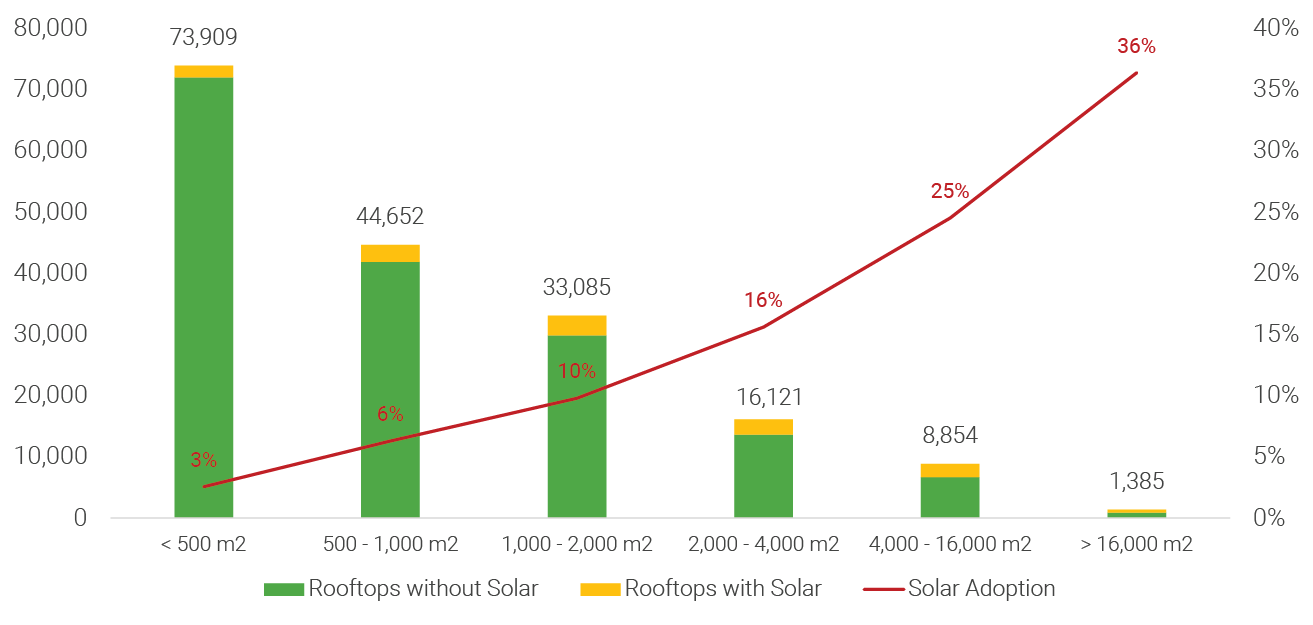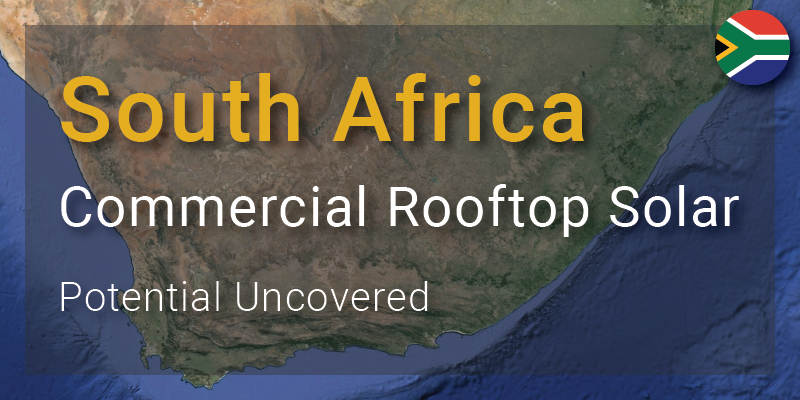South Africa Commercial Rooftop Solar Potential
South Africa’s electricity crisis has made solar energy more than just an option — it’s now a necessity. With load shedding disrupting operations and diesel costs soaring, businesses across the country are turning to their rooftops for solutions. The South Africa commercial rooftop solar potential is enormous, but still largely untapped. So we scanned the country — nearly 180,000 rooftops, to be exact. And the numbers are staggering.
178,006
Total C&I Rooftops
31 GW
Total Solar Potential
7.4%
Solar Adoption
Why South Africa’s Rooftop Solar Market Matters
South Africa is facing one of the most severe electricity shortages in the world. The national grid is aging, unreliable, and overburdened. To stay operational, businesses have been forced to rely on expensive generators, increasing their energy costs and carbon footprint.
In response, solar energy adoption has been growing—but not nearly fast enough. The C&I sector in particular has massive untapped potential. And with recent policy shifts (like the removal of licensing requirements for embedded generation), the conditions are right for a surge in rooftop solar adoption. The real question is: where should companies look first?
What the Rooftop Solar Data Reveals
South Africa’s commercial and industrial (C&I) sector presents a solar opportunity of extraordinary scale. After scanning over 160,000 rooftops using satellite imagery and AI, Planno uncovered a landscape with both immense solar potential and surprising underutilization.
Across the country, we found thousands of buildings large enough to support meaningful solar installations — factories, warehouses, shopping centers, and distribution hubs. Nearly 25,000 of these rooftops exceed 2,000 square meters, making them ideal for cost-effective solar deployment.
Yet despite this infrastructure, solar adoption remains modest. Only 7.3% of C&I rooftops currently have solar installed. That means over 90% of viable rooftops are still sitting idle, despite growing energy insecurity and regulatory incentives.
It’s also worth noting how solar is distributed: the majority of rooftops fall into the mid-sized category (500–4,000 m²), a sweet spot that combines scale with easier installation timelines. These rooftops offer faster deployment and better unit economics for developers — ideal for companies looking to build volume quickly without the complexity of utility-scale projects.
Some provinces, like the Western Cape and Gauteng, have begun to tap into their potential. But even in these regions, untapped capacity still dwarfs what’s currently installed. And in others—like KwaZulu-Natal, Mpumalanga, and North West—the rooftop stock is significant, but adoption has barely begun.
South Africa’s rooftop solar landscape is vast, visible, and mostly untouched. The question isn’t whether the opportunity exists — it’s who will seize it first.

Regional Insights on Solar Potential in South Africa
📍 Gauteng
- 49,919 rooftops – largest provincial count
- 11.1 GWp potential, of which 8.4 GWp remains untapped
- Solar adoption is 10.2% – above the national average
- Rooftops are both large and dense, especially in metro areas like Johannesburg and Ekurhuleni
- This is South Africa’s rooftop powerhouse
📍 Western Cape
- 17,524 rooftops, with 3.5 GWp of potential
- Highest solar adoption rate at 11.4%
- Known for a more progressive energy culture and stable regulatory environment
- Rooftop sizes tend to be smaller, but density is high around Cape Town
📍 KwaZulu-Natal
- 25,877 rooftops, 4.9 GWp potential
- Just 5.1% adoption, meaning over 4.1 GWp is untapped
- Durban and Pietermaritzburg corridors show concentration of large industrial sites
- A big market that’s flying under the radar
📍 Eastern Cape
- 9,278 rooftops, 1.9 GWp potential
- 7.8% adoption—moderate, but improving
- High-quality industrial areas with latent potential in Gqeberha (Port Elizabeth) and East London
📍 Limpopo
- 18,219 rooftops, 2.2 GWp potential
- Low adoption at 4.7%
- Many mid-sized rooftops with good solar suitability—an emerging hotspot
📍 Mpumalanga
- 21,257 rooftops, 2.9 GWp potential
- 5.6% adoption
- Industrial zones tied to mining and logistics—prime for solar independence
📍 North West
- 19,601 rooftops, 2.6 GWp potential
- 4.8% adoption
- High density of medium-to-large rooftops across Rustenburg and Klerksdorp
📍 Free State
- 16,331 rooftops, 2.3 GWp potential
- 6.1% adoption
- Many mid-sized rooftops with good solar suitability.
Key Insights & Takeaways
- Gauteng dominates in both rooftop count and solar potential—it should be every solar company’s first port of call.
- Western Cape is mature, but there’s still room to grow in industrial zones beyond Cape Town.
- KwaZulu-Natal, Mpumalanga, and North West are large, untapped markets—ripe for first-movers.
- Mid-sized rooftops (500–4,000 m²) make up the majority of the national stock and offer the best mix of scale and accessibility.
- Despite policy progress, over 90% of rooftops remain solar-free. The opportunity is now.
How Planno Unlocks Rooftop Solar Opportunities
Planno makes this level of rooftop market intelligence actionable. Our platform uses geospatial AI to identify, size, and qualify rooftops for solar in every region — so you don’t have to guess where to go next. We also help you contact building owners and managers directly, turning intelligence into leads.
🚀 Want to explore rooftops in South Africa?
FAQ
What is the rooftop solar potential in South Africa?
South Africa has over 31 GWp of solar potential across commercial and industrial rooftops, with more than 25 GWp still untapped.
Which region in South Africa has the most commercial rooftops?
Gauteng leads by far, followed by KwaZulu-Natal, North West, and Mpumalanga.
How can I find qualified solar leads in South Africa?
Planno helps solar companies identify, pre-qualify, and contact rooftop owners using AI and satellite data.
